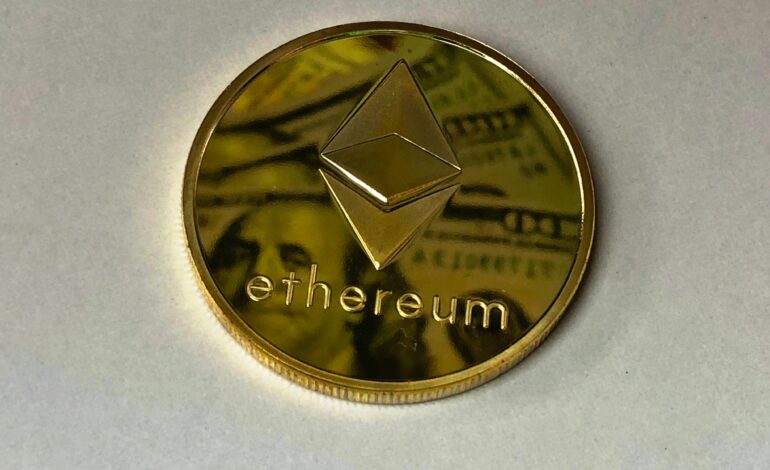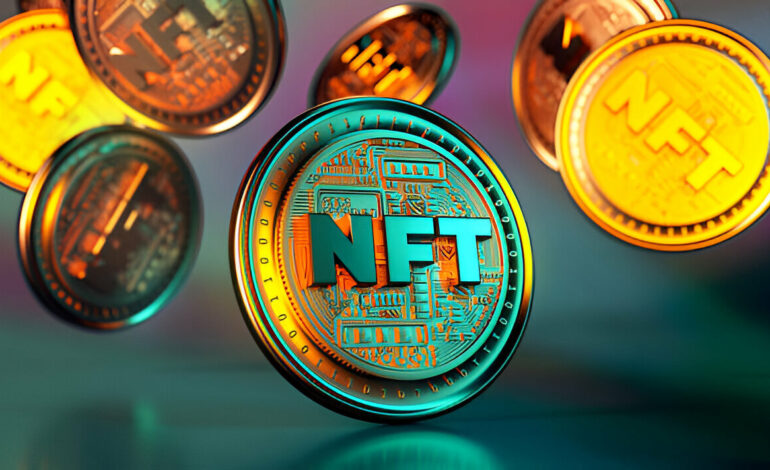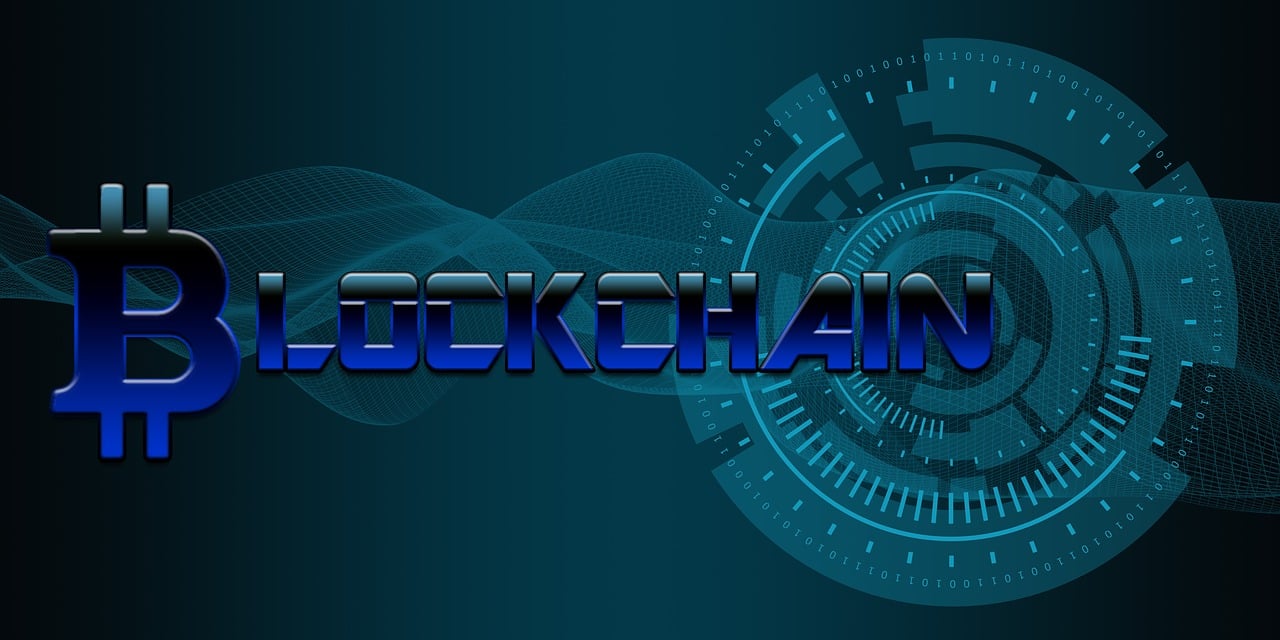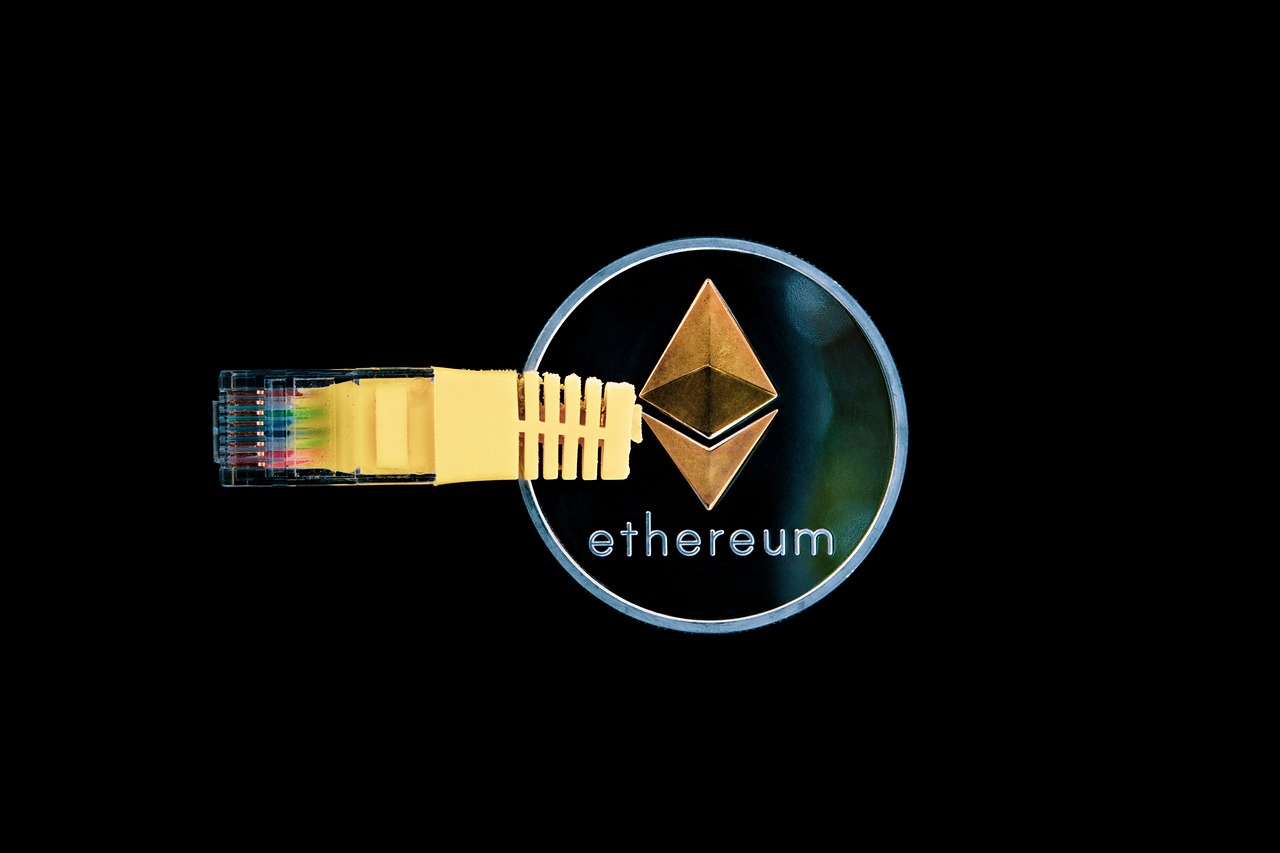Ethereum: Smart Contracts and the Future of DApps

In the world of blockchain and cryptocurrencies, Ethereum stands out as a trailblazer, offering more than just digital currency. It provides a platform for decentralized applications (DApps) and smart contracts, which have the potential to transform industries beyond finance. In this comprehensive guide, we will explore Ethereum, its innovative features, and how it is shaping the future of DApps.
Introduction to Ethereum
Ethereum, launched in 2015 by Vitalik Buterin, is often described as the second generation of blockchain technology. While Bitcoin primarily serves as a digital currency, Ethereum goes beyond this and offers a decentralized platform for creating and running DApps and smart contracts. These two concepts are at the heart of Ethereum’s appeal and its potential to revolutionize various sectors.
Smart Contracts: The Building Blocks of Ethereum
Smart contracts are self-executing contracts with the terms of the agreement directly written into code. They automatically execute when specific conditions are met, without the need for intermediaries. This is a significant departure from traditional contracts, which require trust in a third party to enforce the terms.
Smart contracts on Ethereum are written in a programming language called Solidity. They are stored on the blockchain, making them tamper-proof and transparent. These contracts can be used for a wide range of applications, from simple transactions to complex, multi-step processes.
Use Cases of Smart Contracts
Smart contracts have numerous potential use cases across various industries:
Financial Services: Smart contracts can facilitate the creation and execution of financial agreements, such as loans, insurance, and asset management, without the need for banks or other financial intermediaries.
Supply Chain Management: They can help track the movement of goods and verify the authenticity of products, reducing fraud and improving transparency.
Real Estate: Smart contracts can automate property transfers, making the buying and selling of real estate more efficient and secure.
Healthcare: They can ensure the secure sharing of medical records and automate insurance claims processing.
Legal: Smart contracts can automate legal processes, such as wills and estate planning, reducing legal fees and minimizing disputes.
Voting Systems: They can provide secure and transparent voting systems that are resistant to tampering.
Decentralized Applications (DApps)
DApps are applications built on blockchain technology and typically run on a decentralized network of computers. They offer a wide range of functionalities beyond cryptocurrencies and are designed to be transparent, secure, and resistant to censorship.
Ethereum is the leading platform for creating and deploying DApps. These applications can serve various purposes and industries. Some popular DApps include:
Decentralized Finance (DeFi) Apps: DeFi DApps offer financial services like lending, borrowing, and trading without relying on traditional banks or financial institutions.
Non-Fungible Token (NFT) Marketplaces: NFTs represent unique digital assets and are bought, sold, and traded on DApps.
Gaming: DApps have brought blockchain technology to the gaming world, allowing for in-game asset ownership and unique gaming experiences.
Social Media: Some DApps aim to provide users with more control over their data and interactions on social media platforms.
Supply Chain Management: DApps offer transparency and traceability in supply chain processes, reducing fraud and ensuring the authenticity of products.
Identity Verification: DApps can enhance identity verification processes by providing secure and private solutions.
How Ethereum Works
Ethereum’s functionality is made possible through its unique blockchain architecture. Here’s a simplified overview of how Ethereum operates:
Nodes: Ethereum consists of a network of nodes (computers) that validate and record transactions and execute smart contracts.
Ether (ETH): Ethereum’s native cryptocurrency, Ether, is used to pay for transaction fees and computational services on the network.
Gas: Gas is a unit that measures the computational work required for a transaction or contract execution. Users pay for gas in Ether, and it ensures that the network remains efficient and secure.
Mining: Ethereum uses a consensus mechanism called “proof of work” (PoW) to validate transactions and create new blocks. Miners compete to solve complex mathematical puzzles, and the first to succeed adds a new block to the blockchain.
Ethereum Virtual Machine (EVM): The EVM is the runtime environment for smart contracts. It processes and executes the code in a secure and isolated manner.
Challenges and Solutions
While Ethereum has achieved significant success, it also faces challenges:
Scalability: Ethereum has encountered scalability issues, with network congestion and high gas fees during periods of high demand. To address this, Ethereum 2.0, an upgrade to the network, is being developed, which will transition from PoW to “proof of stake” (PoS) and improve scalability.
Security: Vulnerabilities in smart contracts have led to hacks and financial losses. The Ethereum community continually works to enhance security practices and develop tools for auditing smart contracts.
Regulatory Concerns: Regulatory bodies are exploring how to regulate DApps and tokens. Compliance with evolving regulations is a challenge that the Ethereum community is actively addressing.
User Experience: The complexity of interacting with DApps can be a barrier for mainstream users. Improvements in user interfaces and user experiences are essential for broader adoption.
Environmental Impact: Ethereum’s PoW mechanism consumes a significant amount of energy. The transition to PoS in Ethereum 2.0 aims to reduce its environmental footprint.
The Road Ahead: Ethereum 2.0 and Beyond
Ethereum 2.0, often referred to as ETH 2.0 or Serenity, represents a significant upgrade to the Ethereum network. The primary objectives of Ethereum 2.0 are to improve scalability, security, and sustainability.
Key features of Ethereum 2.0 include:
Proof of Stake: The transition from PoW to PoS, where validators are chosen to create new blocks and validate transactions based on the amount of cryptocurrency they hold and “stake.”
Sharding: Sharding will allow the network to process multiple transactions and smart contracts simultaneously, significantly increasing throughput and scalability.
eWASM: eWASM is a new execution environment that will make it possible to write smart contracts in a variety of programming languages, expanding the capabilities of Ethereum.
Crosslinks and Beacon Chain: These components will enhance the security and coordination of the Ethereum network.
Ethereum 2.0 aims to address many of the challenges that Ethereum currently faces, such as scalability and energy consumption, making it more efficient and sustainable. This upgrade is being rolled out in multiple phases, with the full transition expected to take place over the coming years.
The Future of DApps
As Ethereum evolves and DApps become more prevalent, they are expected to play a significant role in various industries. Here are some potential future developments and applications for DApps:
Decentralized Finance (DeFi) Expansion: DeFi DApps are likely to continue expanding, offering a broader range of financial services, potentially rivaling traditional finance systems.
Enterprise Adoption: Businesses may increasingly use DApps for supply chain management, identity verification, and other operational processes.
Gaming and Entertainment: The gaming industry is expected to see a surge in blockchain-based games and virtual worlds, with assets and experiences owned by players.
Privacy and Security: DApps focusing on privacy and security are expected to emerge, providing users with more control over their data and online activities.
Social Media and Content Platforms: DApps may offer alternatives to traditional social media and content-sharing platforms, giving users more control over their content and data.
Government and Civic Use Cases: DApps could be employed for secure voting systems, government transparency, and public service delivery.
Conclusion
Ethereum has ushered in a new era of blockchain technology by introducing smart contracts and DApps. It has the potential to transform industries beyond finance, offering transparency, security, and efficiency. While Ethereum faces challenges, its ongoing development and the transition to Ethereum 2.0 hold promise for a more scalable, sustainable, and secure future.
DApps are at the forefront of blockchain innovation, providing unique solutions for a variety of industries and applications. As the technology continues to evolve, the future of DApps is bright, and they are likely to become integral to how we conduct business, interact online, and manage various aspects of our lives. Staying informed about these developments is essential for anyone interested in the world of blockchain and decentralized applications.

 Bitcoin
Bitcoin  Ethereum
Ethereum  Tether
Tether  XRP
XRP  USDC
USDC  TRON
TRON  Lido Staked Ether
Lido Staked Ether  Dogecoin
Dogecoin  Figure Heloc
Figure Heloc  Cardano
Cardano  WhiteBIT Coin
WhiteBIT Coin  Bitcoin Cash
Bitcoin Cash  Wrapped stETH
Wrapped stETH  Wrapped Bitcoin
Wrapped Bitcoin  USDS
USDS  Binance Bridged USDT (BNB Smart Chain)
Binance Bridged USDT (BNB Smart Chain)  Wrapped eETH
Wrapped eETH  Chainlink
Chainlink  Monero
Monero  LEO Token
LEO Token  WETH
WETH  Stellar
Stellar  Zcash
Zcash  Ethena USDe
Ethena USDe  Coinbase Wrapped BTC
Coinbase Wrapped BTC  Litecoin
Litecoin  Hyperliquid
Hyperliquid  Sui
Sui  Avalanche
Avalanche  Hedera
Hedera  sUSDS
sUSDS  Dai
Dai  USDT0
USDT0  Shiba Inu
Shiba Inu  PayPal USD
PayPal USD  Cronos
Cronos  World Liberty Financial
World Liberty Financial  Toncoin
Toncoin  Uniswap
Uniswap  Ethena Staked USDe
Ethena Staked USDe  Mantle
Mantle  Canton
Canton  USD1
USD1  Polkadot
Polkadot  Rain
Rain  Bitget Token
Bitget Token  MemeCore
MemeCore  Tether Gold
Tether Gold  OKB
OKB  Aave
Aave  Falcon USD
Falcon USD  Bittensor
Bittensor  NEAR Protocol
NEAR Protocol  Ethereum Classic
Ethereum Classic  Binance-Peg WETH
Binance-Peg WETH  BlackRock USD Institutional Digital Liquidity Fund
BlackRock USD Institutional Digital Liquidity Fund  Jito Staked SOL
Jito Staked SOL  Pi Network
Pi Network  Pepe
Pepe  Internet Computer
Internet Computer  PAX Gold
PAX Gold  syrupUSDC
syrupUSDC  Aster
Aster  Circle USYC
Circle USYC  HTX DAO
HTX DAO  Solana
Solana  Global Dollar
Global Dollar  Ethena
Ethena  Sky
Sky  Jupiter Perpetuals Liquidity Provider Token
Jupiter Perpetuals Liquidity Provider Token  KuCoin
KuCoin  Ripple USD
Ripple USD  BFUSD
BFUSD  Binance Bridged USDC (BNB Smart Chain)
Binance Bridged USDC (BNB Smart Chain)  Midnight
Midnight  Worldcoin
Worldcoin  Rocket Pool ETH
Rocket Pool ETH  Gate
Gate  Ondo
Ondo  Aptos
Aptos  Binance Staked SOL
Binance Staked SOL  Wrapped BNB
Wrapped BNB  POL (ex-MATIC)
POL (ex-MATIC)  Quant
Quant  Arbitrum
Arbitrum  Janus Henderson Anemoy AAA CLO Fund
Janus Henderson Anemoy AAA CLO Fund  Pump.fun
Pump.fun  Algorand
Algorand  Lombard Staked BTC
Lombard Staked BTC  Official Trump
Official Trump  Function FBTC
Function FBTC  Cosmos Hub
Cosmos Hub  Filecoin
Filecoin  NEXO
NEXO  Solv Protocol BTC
Solv Protocol BTC  VeChain
VeChain  USDtb
USDtb  Liquid Staked ETH
Liquid Staked ETH  USDD
USDD  Superstate Short Duration U.S. Government Securities Fund (USTB)
Superstate Short Duration U.S. Government Securities Fund (USTB)  OUSG
OUSG  WrappedM by M^0
WrappedM by M^0  Beldex
Beldex  Polygon Bridged USDC (Polygon PoS)
Polygon Bridged USDC (Polygon PoS)  Sei
Sei  Arbitrum Bridged WBTC (Arbitrum One)
Arbitrum Bridged WBTC (Arbitrum One)  clBTC
clBTC  Ondo US Dollar Yield
Ondo US Dollar Yield  Mantle Staked Ether
Mantle Staked Ether  USDai
USDai  syrupUSDT
syrupUSDT  Renzo Restaked ETH
Renzo Restaked ETH  Bonk
Bonk  Render
Render  Wrapped Flare
Wrapped Flare  Polygon PoS Bridged DAI (Polygon POS)
Polygon PoS Bridged DAI (Polygon POS)  L2 Standard Bridged WETH (Base)
L2 Standard Bridged WETH (Base)  PancakeSwap
PancakeSwap  Kinetiq Staked HYPE
Kinetiq Staked HYPE  MYX Finance
MYX Finance  Jupiter
Jupiter  StakeWise Staked ETH
StakeWise Staked ETH  Jupiter Staked SOL
Jupiter Staked SOL  Usual USD
Usual USD  Pudgy Penguins
Pudgy Penguins  Curve DAO
Curve DAO  c8ntinuum
c8ntinuum  tBTC
tBTC  Arbitrum Bridged WETH (Arbitrum One)
Arbitrum Bridged WETH (Arbitrum One)  Optimism
Optimism  Spiko EU T-Bills Money Market Fund
Spiko EU T-Bills Money Market Fund  GHO
GHO  TrueUSD
TrueUSD  Story
Story  cgETH Hashkey Cloud
cgETH Hashkey Cloud  pippin
pippin  Merlin Chain
Merlin Chain  Artificial Superintelligence Alliance
Artificial Superintelligence Alliance  Lido DAO
Lido DAO  GTETH
GTETH  Dash
Dash  Tezos
Tezos  Injective
Injective  Ether.fi
Ether.fi  Virtuals Protocol
Virtuals Protocol  AB
AB  Stacks
Stacks  Stader ETHx
Stader ETHx  SPX6900
SPX6900  Ether.Fi Liquid ETH
Ether.Fi Liquid ETH  Aerodrome Finance
Aerodrome Finance  Marinade Staked SOL
Marinade Staked SOL  Audiera
Audiera  sBTC
sBTC  Swell Ethereum
Swell Ethereum  Wrapped ApeCoin
Wrapped ApeCoin  JUST
JUST  Sun Token
Sun Token  Starknet
Starknet  The Graph
The Graph  FLOKI
FLOKI  BitTorrent
BitTorrent  Coinbase Wrapped Staked ETH
Coinbase Wrapped Staked ETH  Steakhouse USDC Morpho Vault
Steakhouse USDC Morpho Vault  Celestia
Celestia  DoubleZero
DoubleZero  Bitcoin SV
Bitcoin SV  AINFT
AINFT  EURC
EURC  Olympus
Olympus  Telcoin
Telcoin  Ethereum Name Service
Ethereum Name Service  Chiliz
Chiliz  Conflux
Conflux  Maple Finance
Maple Finance  Cap USD
Cap USD  Avalanche Bridged BTC (Avalanche)
Avalanche Bridged BTC (Avalanche)  IOTA
IOTA  Kinesis Gold
Kinesis Gold  Trust Wallet
Trust Wallet  Resolv USR
Resolv USR  crvUSD
crvUSD  Kaia
Kaia  Pyth Network
Pyth Network  Binance-Peg Dogecoin
Binance-Peg Dogecoin  Resolv wstUSR
Resolv wstUSR  Gnosis
Gnosis  dogwifhat
dogwifhat  Binance-Peg BUSD
Binance-Peg BUSD  Basic Attention
Basic Attention  JasmyCoin
JasmyCoin  Arbitrum Bridged Wrapped eETH (Arbitrum)
Arbitrum Bridged Wrapped eETH (Arbitrum)  BENQI Liquid Staked AVAX
BENQI Liquid Staked AVAX  Vision
Vision  ether.fi Staked ETH
ether.fi Staked ETH  Humanity
Humanity  The Sandbox
The Sandbox  Unit Bitcoin
Unit Bitcoin  Helium
Helium  GALA
GALA  Pendle
Pendle  Legacy Frax Dollar
Legacy Frax Dollar  Fartcoin
Fartcoin  Mantle Restaked ETH
Mantle Restaked ETH  Flow
Flow  Kinesis Silver
Kinesis Silver  Zebec Network
Zebec Network  Polygon PoS Bridged WETH (Polygon POS)
Polygon PoS Bridged WETH (Polygon POS)  Theta Network
Theta Network  Fidelity Digital Interest Token
Fidelity Digital Interest Token  Janus Henderson Anemoy Treasury Fund
Janus Henderson Anemoy Treasury Fund  Gate Wrapped BTC
Gate Wrapped BTC  Sonic
Sonic  MimbleWimbleCoin
MimbleWimbleCoin  SwissBorg
SwissBorg  Decred
Decred  Aster Staked BNB
Aster Staked BNB  LayerZero
LayerZero  BTSE Token
BTSE Token  Binance Wrapped BTC
Binance Wrapped BTC  Plasma
Plasma  NEO
NEO  Mantle Bridged WETH (Mantle)
Mantle Bridged WETH (Mantle)  Wrapped STX (Velar)
Wrapped STX (Velar)  Ape and Pepe
Ape and Pepe  Raydium
Raydium  Staked USDai
Staked USDai  ZKsync
ZKsync  Compound
Compound  Arbitrum Bridged wstETH (Arbitrum)
Arbitrum Bridged wstETH (Arbitrum)  Wrapped HYPE
Wrapped HYPE  Noble USDC
Noble USDC  Wrapped Aave Ethereum USDC
Wrapped Aave Ethereum USDC  RealLink
RealLink  Decentraland
Decentraland  USDa
USDa  YLDS
YLDS  Monad
Monad  Falcon Finance
Falcon Finance  Arweave
Arweave  AUSD
AUSD  Quantum Resistant Ledger
Quantum Resistant Ledger  Drift Staked SOL
Drift Staked SOL  Bybit Staked SOL
Bybit Staked SOL  Terra Luna Classic
Terra Luna Classic  Savings Dai
Savings Dai  WeFi
WeFi  Blockchain Capital
Blockchain Capital  Loaded Lions
Loaded Lions  1INCH
1INCH  Polygon Bridged WBTC (Polygon POS)
Polygon Bridged WBTC (Polygon POS)  Wrapped AVAX
Wrapped AVAX  eCash
eCash  Golem
Golem  BUILDon
BUILDon  Solv Protocol Staked BTC
Solv Protocol Staked BTC  Legacy Token
Legacy Token  THORChain
THORChain  Fluid
Fluid  Treehouse ETH
Treehouse ETH  Tradable NA Rent Financing Platform SSTN
Tradable NA Rent Financing Platform SSTN  InfiniFi USD
InfiniFi USD  Staked Cap USD
Staked Cap USD  MX
MX  Cheems Token
Cheems Token  Ultima
Ultima  Immutable
Immutable  Lombard
Lombard  OriginTrail
OriginTrail  EigenCloud (prev. EigenLayer)
EigenCloud (prev. EigenLayer)  Walrus
Walrus  Cronos Bridged USDC (Cronos)
Cronos Bridged USDC (Cronos)  MultiversX
MultiversX  Wrapped Aave Ethereum USDT
Wrapped Aave Ethereum USDT  Zora
Zora  ApeCoin
ApeCoin  Ethena Staked ENA
Ethena Staked ENA  UCHAIN
UCHAIN  Kamino
Kamino  Wormhole
Wormhole  Aster USDF
Aster USDF  WEMIX
WEMIX  Stable
Stable  Onyxcoin
Onyxcoin  0G
0G  Theo Short Duration US Treasury Fund
Theo Short Duration US Treasury Fund  Satoshi Stablecoin
Satoshi Stablecoin  KOGE
KOGE  Kraken Wrapped BTC
Kraken Wrapped BTC  StandX DUSD
StandX DUSD  Ribbita by Virtuals
Ribbita by Virtuals  Convex Finance
Convex Finance  Spiko US T-Bills Money Market Fund
Spiko US T-Bills Money Market Fund  BitMart
BitMart  Flare Bridged XRP (Flare)
Flare Bridged XRP (Flare)  SOON
SOON  SafePal
SafePal  SoSoValue
SoSoValue  Reserve Rights
Reserve Rights  GUSD
GUSD  Bedrock BTC
Bedrock BTC  Jito
Jito  STASIS EURO
STASIS EURO  Amp
Amp  Midas mF-ONE
Midas mF-ONE  Synthetix
Synthetix  Wrapped Pulse
Wrapped Pulse  Brett
Brett  Aethir
Aethir  Tokenize Xchange
Tokenize Xchange  Resolv Liquidity Provider Token
Resolv Liquidity Provider Token  Origin Ether
Origin Ether  Axie Infinity
Axie Infinity  Livepeer
Livepeer  SuperVerse
SuperVerse  Nexus Mutual
Nexus Mutual  MetaDAO
MetaDAO  Wrapped Ethereum (Sollet)
Wrapped Ethereum (Sollet)  Alchemist AI
Alchemist AI  Binance-Peg SOL
Binance-Peg SOL  GoMining Token
GoMining Token  Theta Fuel
Theta Fuel  DeXe
DeXe  Universal BTC
Universal BTC  Apollo Diversified Credit Securitize Fund
Apollo Diversified Credit Securitize Fund  StarkGate Bridged USDC (Starknet)
StarkGate Bridged USDC (Starknet)  dYdX
dYdX  Qtum
Qtum  Phantom Staked SOL
Phantom Staked SOL  Prom
Prom  Four
Four  Grass
Grass  The American Dream
The American Dream  Concordium
Concordium  Creditcoin
Creditcoin  RaveDAO
RaveDAO  DOLA
DOLA  Frax USD
Frax USD  Bridged Wrapped Ether (Linea)
Bridged Wrapped Ether (Linea)  Kusama
Kusama  Ozone Chain
Ozone Chain  Rollbit Coin
Rollbit Coin  Gauntlet USDC Prime Morpho Vault
Gauntlet USDC Prime Morpho Vault  Conscious Token
Conscious Token  Pleasing USD
Pleasing USD  Velo
Velo  Toshi
Toshi  币安人生 (BinanceLife)
币安人生 (BinanceLife)  ether.fi weETHs
ether.fi weETHs  CoW Protocol
CoW Protocol  Core
Core  Gas
Gas  Polygon Bridged weETH (Katana)
Polygon Bridged weETH (Katana)  AIOZ Network
AIOZ Network  Super OETH
Super OETH  PayFi Strategy Token USDC
PayFi Strategy Token USDC  KAITO
KAITO  Movement
Movement  Meteora
Meteora  yearn.finance
yearn.finance  Gaib AI Dollar Alpha USDC
Gaib AI Dollar Alpha USDC  Impossible Cloud Network Token
Impossible Cloud Network Token  ADI
ADI  Staked TRX
Staked TRX  Turbo
Turbo  Crypto.com Staked ETH
Crypto.com Staked ETH  MAG7.ssi
MAG7.ssi  Railgun
Railgun  Nervos Network
Nervos Network  Rekt
Rekt  Shuffle
Shuffle  AWE Network
AWE Network  Anzen USDz
Anzen USDz  KUB Coin
KUB Coin  Ravencoin
Ravencoin  Linea
Linea  ETHPlus
ETHPlus  Niza Global
Niza Global  Akash Network
Akash Network  cWBTC
cWBTC  Wrapped Aave Ethereum WETH
Wrapped Aave Ethereum WETH  DigiByte
DigiByte  Wrapped Savings rUSD
Wrapped Savings rUSD  Tradable Singapore Fintech SSL
Tradable Singapore Fintech SSL  Baby Doge Coin
Baby Doge Coin  Ring USD
Ring USD  QOM One Bridged USDT (QL1)
QOM One Bridged USDT (QL1)  Keeta
Keeta  USDA
USDA  Arkham
Arkham  Ronin
Ronin  Ether.fi Staked BTC
Ether.fi Staked BTC  MNEE USD Stablecoin
MNEE USD Stablecoin  Savings xDAI
Savings xDAI  Melania Meme
Melania Meme  0x Protocol
0x Protocol  BurnedFi
BurnedFi  Dog (Bitcoin)
Dog (Bitcoin)  Threshold Network
Threshold Network  CASH
CASH  Avantis
Avantis  Mina Protocol
Mina Protocol  AgentFun.AI
AgentFun.AI  Qubic
Qubic  Novem Pro
Novem Pro  CoinEx
CoinEx  Open Campus
Open Campus  TempleDAO
TempleDAO  Nano
Nano  Avant USD
Avant USD  Hastra Wrapped YLDS
Hastra Wrapped YLDS  TDCCP
TDCCP  Renzo Restaked LST
Renzo Restaked LST  cETH
cETH  Wrapped Glue
Wrapped Glue  Babypie Wrapped BTC
Babypie Wrapped BTC  PRIME
PRIME  COCA
COCA  Cronos Bridged USDT (Cronos)
Cronos Bridged USDT (Cronos)  Pleasing Gold
Pleasing Gold  Zilliqa
Zilliqa  Drift Protocol
Drift Protocol  Safe
Safe  Unibase
Unibase  AI Companions
AI Companions  Staked HYPE
Staked HYPE  Nexpace
Nexpace  Luxxcoin
Luxxcoin  DeepBook
DeepBook  ViciCoin
ViciCoin  staked USD1+
staked USD1+  Jelly-My-Jelly
Jelly-My-Jelly  Pieverse
Pieverse  GMX
GMX  Holo
Holo  Metal Blockchain
Metal Blockchain  VanEck Treasury Fund
VanEck Treasury Fund  River
River  Re Protocol reUSD
Re Protocol reUSD  ZIGChain
ZIGChain  INI
INI  Avant Staked USD
Avant Staked USD  VVS Finance
VVS Finance  SentismAI
SentismAI  Midas mHYPER
Midas mHYPER  Siacoin
Siacoin  Vana
Vana  MANTRA
MANTRA  Kava
Kava  Axelar
Axelar  Astar
Astar  Mog Coin
Mog Coin  QuantixAI
QuantixAI  ORDI
ORDI  Moonwell Flagship ETH (Morpho Vault)
Moonwell Flagship ETH (Morpho Vault)  Moca Network
Moca Network  Berachain
Berachain  VeThor
VeThor  VaultBridge Bridged WBTC (Katana)
VaultBridge Bridged WBTC (Katana)  OpenEden OpenDollar
OpenEden OpenDollar  Swop
Swop  sUSDa
sUSDa  EUR CoinVertible
EUR CoinVertible  Sushi
Sushi  coco
coco  Magic Eden
Magic Eden  HashKey Platform Token
HashKey Platform Token  Popcat
Popcat  Gama Token
Gama Token  Comedian
Comedian  Slash Vision Labs
Slash Vision Labs  Felix feUSD
Felix feUSD  Oasis
Oasis  Non-Playable Coin
Non-Playable Coin  XPR Network
XPR Network  BCGame Coin
BCGame Coin  OKX Wrapped BTC
OKX Wrapped BTC  ChainOpera AI
ChainOpera AI  XYO Network
XYO Network  Blur
Blur  Terra
Terra  Puff The Dragon
Puff The Dragon  Power Protocol
Power Protocol  cat in a dogs world
cat in a dogs world  Numeraire
Numeraire  Bio Protocol
Bio Protocol  Verus
Verus  Succinct
Succinct  Bridged Ether (StarkGate)
Bridged Ether (StarkGate)  Chia
Chia  Paycoin
Paycoin  ONFA
ONFA  Matrixdock Gold
Matrixdock Gold  Moo Deng
Moo Deng  Loopring
Loopring  L2 Standard Bridged WETH (Optimism)
L2 Standard Bridged WETH (Optimism)  Peanut the Squirrel
Peanut the Squirrel  Optio
Optio  aelf
aelf  Centrifuge
Centrifuge  MindWaveDAO
MindWaveDAO  Celo
Celo  Waves
Waves  AtomOne
AtomOne  Stargate Bridged USDC
Stargate Bridged USDC  earnAUSD
earnAUSD  Venus
Venus  Chutes
Chutes  Orca
Orca  pumpBTC
pumpBTC  Yooldo Games
Yooldo Games  Bridged Wrapped stETH (Gnosis)
Bridged Wrapped stETH (Gnosis)  Compounding OpenDollar
Compounding OpenDollar  Polymesh
Polymesh  IoTeX
IoTeX  Onchain Yield Coin
Onchain Yield Coin  Sahara AI
Sahara AI  Binance-Peg SHIB
Binance-Peg SHIB  Wrapped Centrifuge
Wrapped Centrifuge  Giggle Fund
Giggle Fund  Omni Network [Old]
Omni Network [Old]  RedStone
RedStone  DFDV Staked SOL
DFDV Staked SOL  Space and Time
Space and Time  Recall
Recall  Irys
Irys  Ankr Network
Ankr Network  UMA
UMA  BitDCA
BitDCA  Fluid Wrapped Staked ETH
Fluid Wrapped Staked ETH  Geodnet
Geodnet  USDX
USDX  HOME
HOME  Api3
Api3  SKALE
SKALE  stUSDT Staked USDT
stUSDT Staked USDT  Sign
Sign  Frax (prev. FXS)
Frax (prev. FXS)  APEX
APEX  Arbitrum Bridged USDC (Arbitrum)
Arbitrum Bridged USDC (Arbitrum)  Pundi X
Pundi X  GOHOME
GOHOME  Gold Park
Gold Park  Venice Token
Venice Token  LCX
LCX  Ardor
Ardor  Useless Coin
Useless Coin  Memecoin
Memecoin  Lagrange
Lagrange  f(x) USD Saving
f(x) USD Saving  Mask Network
Mask Network  SSV Network
SSV Network  BIM
BIM  OVERTAKE
OVERTAKE  Magic Internet Money (Ethereum)
Magic Internet Money (Ethereum)  AltLayer
AltLayer  EthereumPoW
EthereumPoW  opBNB Bridged USDT (opBNB)
opBNB Bridged USDT (opBNB)  ECOMI
ECOMI  OG Fan Token
OG Fan Token  BUSD
BUSD  Sologenic
Sologenic  Apertum
Apertum  APEX
APEX  Avalanche Bridged WETH (Avalanche)
Avalanche Bridged WETH (Avalanche)  FOLKS
FOLKS  Huma Finance
Huma Finance  Status
Status  Law Blocks
Law Blocks  Plume
Plume  Animecoin
Animecoin  Unit Pump
Unit Pump  Pirate Chain
Pirate Chain  Wrapped CRO
Wrapped CRO  Band
Band  Euler
Euler  Escoin
Escoin  COTI
COTI  Illuvium
Illuvium  Tokenlon
Tokenlon  Stargate Bridged WETH
Stargate Bridged WETH  Tellor Tributes
Tellor Tributes  Doodles
Doodles  Tesla xStock
Tesla xStock  Steakhouse ETH Morpho Vault
Steakhouse ETH Morpho Vault  Harmony
Harmony  Pax Dollar
Pax Dollar  Dialectic USD Vault
Dialectic USD Vault  Zedxion
Zedxion  Enjin Coin
Enjin Coin  WorldAssets
WorldAssets  ChangeNOW
ChangeNOW  Siren
Siren  PYTHIA
PYTHIA  Notcoin
Notcoin  USDKG
USDKG  HumidiFi
HumidiFi  VaultBridge Bridged USDC (Katana)
VaultBridge Bridged USDC (Katana)  WOO
WOO  Helder
Helder  Decentralized Social
Decentralized Social  VaultBridge Bridged ETH (Katana)
VaultBridge Bridged ETH (Katana)  Binance-Peg ZEC
Binance-Peg ZEC  TAGGER
TAGGER  SAFEbit
SAFEbit  Ontology
Ontology  CARV
CARV  Hex Trust USD
Hex Trust USD  IOST
IOST  ARK
ARK  Sui Bridged WBTC (Sui)
Sui Bridged WBTC (Sui)  Babylon
Babylon  VeraOne
VeraOne  Overnight.fi USD+
Overnight.fi USD+  Orbs
Orbs  Mountain Protocol USD
Mountain Protocol USD  Ronin Bridged WETH (Ronin)
Ronin Bridged WETH (Ronin)  YZY
YZY  Kinetiq Earn Vault
Kinetiq Earn Vault  SMARDEX
SMARDEX  Sygnum FIUSD Liquidity Fund
Sygnum FIUSD Liquidity Fund  Infrared Bera
Infrared Bera  Hive
Hive  Fulcrom
Fulcrom  MarsMi
MarsMi  Moonwell Flagship USDC (Morpho Vault)
Moonwell Flagship USDC (Morpho Vault)  Firelight Staked XRP
Firelight Staked XRP  Unit Plasma
Unit Plasma  Constellation
Constellation  ConstitutionDAO
ConstitutionDAO  MVL
MVL  iExec RLC
iExec RLC  NKYC Token
NKYC Token  Mezo Wrapped BTC
Mezo Wrapped BTC  Gemini Dollar
Gemini Dollar  StraitsX XUSD
StraitsX XUSD  Sui Bridged USDT (Sui)
Sui Bridged USDT (Sui)  Whiteheart
Whiteheart  rsERG
rsERG  StorX
StorX  BORA
BORA  Solar
Solar  Aegis YUSD
Aegis YUSD  Spark
Spark  GMT
GMT  Yield Guild Games
Yield Guild Games  Cronos Bridged WBTC (Cronos)
Cronos Bridged WBTC (Cronos)  Bancor Network
Bancor Network  Lisk
Lisk  Hivemapper
Hivemapper  Bridged Wrapped Bitcoin (StarkGate)
Bridged Wrapped Bitcoin (StarkGate)  Stargate Finance
Stargate Finance  Derive
Derive  Midas mTBILL
Midas mTBILL  SWFTCOIN
SWFTCOIN  KGeN
KGeN  Degen
Degen  Energy Web
Energy Web  Neiro
Neiro  Sui Bridged Ether (Sui)
Sui Bridged Ether (Sui)  Linea Bridged USDT (Linea)
Linea Bridged USDT (Linea)  AI Rig Complex
AI Rig Complex  Wrapped Bitcoin (PulseChain)
Wrapped Bitcoin (PulseChain)  Lista DAO
Lista DAO  Austin Capitals
Austin Capitals  Sai
Sai  Tornado Cash
Tornado Cash  Glidr
Glidr  Bridged NXPC
Bridged NXPC  bitcastle Token
bitcastle Token  BOLD
BOLD  Binance-Peg DAI
Binance-Peg DAI  CJournal
CJournal  Spell
Spell  Shentu
Shentu  Cross
Cross  Powerledger
Powerledger  Balancer
Balancer  Flux
Flux  Cloud
Cloud  Ondo U.S. Dollar Token
Ondo U.S. Dollar Token  UnifAI Network
UnifAI Network  Nirvana ANA
Nirvana ANA  Amnis Aptos
Amnis Aptos  Avalanche Bridged USDC (Avalanche)
Avalanche Bridged USDC (Avalanche)  Stronghold
Stronghold  Noble Dollar (USDN)
Noble Dollar (USDN)  Audius
Audius  Anoma
Anoma  XPIN Network
XPIN Network  Bonfida
Bonfida  Atoshi
Atoshi  Somnia
Somnia  Synthetix sUSD
Synthetix sUSD  Cysic
Cysic  Rocket Pool
Rocket Pool  Celium
Celium  AgentLISA
AgentLISA  Xertra
Xertra  Gems VIP
Gems VIP  Hermez Network
Hermez Network  Tokamak Network
Tokamak Network  BOOK OF MEME
BOOK OF MEME  Kyber Network Crystal
Kyber Network Crystal  Coinbase Wrapped XRP
Coinbase Wrapped XRP  Osmosis
Osmosis  Liquity
Liquity  Usual
Usual  Swarm Network
Swarm Network  Lava Network
Lava Network  Lista USD
Lista USD  Fractal Bitcoin
Fractal Bitcoin  Alchemy Pay
Alchemy Pay  CYBER
CYBER  Bitlight
Bitlight  Ergo
Ergo  Blast
Blast  Echelon Prime
Echelon Prime  Osaka Protocol
Osaka Protocol  Act I The AI Prophecy
Act I The AI Prophecy  Sanctum Infinity
Sanctum Infinity  BOTXCOIN
BOTXCOIN  Songbird
Songbird  TerraClassicUSD
TerraClassicUSD  Big Time
Big Time  Unipoly
Unipoly  Avici
Avici  WAX
WAX  Metis
Metis  io.net
io.net  IQ
IQ  Corn
Corn  Liquity USD
Liquity USD  BLOCKv
BLOCKv  Ridges AI
Ridges AI  Orderly
Orderly  Anvil
Anvil  PumpMeme
PumpMeme  Gigachad
Gigachad  Snowbank
Snowbank  Bit2Me
Bit2Me  TokenPocket Token
TokenPocket Token  OpenLedger
OpenLedger  BTU Protocol
BTU Protocol  Ontology Gas
Ontology Gas  MiL.k
MiL.k  HarryPotterObamaSonic10Inu (ETH)
HarryPotterObamaSonic10Inu (ETH)  The Grays Currency
The Grays Currency  Hylo USD
Hylo USD  Proprietary Trading Network
Proprietary Trading Network  Bounce
Bounce  Hypha Staked AVAX
Hypha Staked AVAX  Wrapped NXM
Wrapped NXM  Caldera
Caldera  Victoria VR
Victoria VR  Hive Dollar
Hive Dollar  Banana For Scale
Banana For Scale  Solayer
Solayer  AIntivirus
AIntivirus  Minidoge
Minidoge  Chromia
Chromia  Chain-key Bitcoin
Chain-key Bitcoin  Ocean Protocol
Ocean Protocol  Aevo
Aevo  Steem
Steem  Gains Network
Gains Network  Achain
Achain  Zentry
Zentry  CargoX
CargoX  Global Commercial Business
Global Commercial Business  Honey
Honey  Wrapped BCH
Wrapped BCH  Nym
Nym  Secret
Secret  Wrapped XRP
Wrapped XRP  Moonwell
Moonwell  XT Stablecoin XTUSD
XT Stablecoin XTUSD  Mango Network
Mango Network  Manta Network
Manta Network  Universal ETH
Universal ETH  Across Protocol
Across Protocol  Targon
Targon  PinkSale
PinkSale  SkyAI
SkyAI  Yield Basis
Yield Basis  Marlin
Marlin  Cobak
Cobak  Goatseus Maximus
Goatseus Maximus  USTBL
USTBL  DIA
DIA  Yuzu USD
Yuzu USD  Wrapped SEI
Wrapped SEI  Rootstock Infrastructure Framework
Rootstock Infrastructure Framework  哈基米 (Hajimi)
哈基米 (Hajimi)  Avalanche Bridged WBTC (Avalanche)
Avalanche Bridged WBTC (Avalanche)  SATS (Ordinals)
SATS (Ordinals)  Dacxi
Dacxi  f(x) Protocol fxUSD
f(x) Protocol fxUSD  DEAPCOIN
DEAPCOIN  Gravity (by Galxe)
Gravity (by Galxe)  Aurora
Aurora  Restaking Vault ETH
Restaking Vault ETH  Purr
Purr  Yield Optimizer ETH
Yield Optimizer ETH  Kujira
Kujira  Treasure
Treasure  Wrapped BTT (Tron)
Wrapped BTT (Tron)  BSquared Network
BSquared Network  Tree
Tree  Amiko
Amiko  sETH
sETH  Ventuals vHYPE
Ventuals vHYPE  Rainbow Bridged USDT (Near)
Rainbow Bridged USDT (Near)  TROLL
TROLL  GAL (migrated to Gravity - G)
GAL (migrated to Gravity - G)  Aergo
Aergo  zkPass
zkPass  ao Computer
ao Computer  Metal DAO
Metal DAO  Sad Coin
Sad Coin  XT.com
XT.com  dKargo
dKargo  Chainflip
Chainflip  tokenbot
tokenbot  Diverge Loop
Diverge Loop  Bifrost
Bifrost  Delysium
Delysium  Magma Finance
Magma Finance  Sapien
Sapien  Auki
Auki  Advertise Coin
Advertise Coin  Yield Optimizer USD
Yield Optimizer USD  Daku V2
Daku V2  WINkLink
WINkLink  Carrot
Carrot  Dialectic ETH Vault
Dialectic ETH Vault  sDOLA
sDOLA  Dymension
Dymension  Velvet
Velvet  Lucidum
Lucidum  Stables Labs USDX
Stables Labs USDX  Hunt
Hunt  Vine
Vine  MetaArena
MetaArena  Zerebro
Zerebro  PHALA
PHALA  infiniFi Locked iUSD (1week)
infiniFi Locked iUSD (1week)  Dogelon Mars
Dogelon Mars  ORE
ORE  Electronic USD
Electronic USD  Cartesi
Cartesi  Lorenzo stBTC
Lorenzo stBTC  QuarkChain
QuarkChain  A Hunters Dream
A Hunters Dream  Metaplex
Metaplex  Syndicate
Syndicate  Medibloc
Medibloc  DORA
DORA  MAI
MAI  Adshares
Adshares  Smooth Love Potion
Smooth Love Potion  Predictions
Predictions  Acet
Acet  Yei Finance
Yei Finance  Infrared Finance
Infrared Finance  Uquid Coin
Uquid Coin  B3 (Base)
B3 (Base)  Sophon
Sophon  Wiki Cat
Wiki Cat  Aster Staked USDF
Aster Staked USDF  SPDR S&P 500 ETF (Ondo Tokenized ETF)
SPDR S&P 500 ETF (Ondo Tokenized ETF)  aixbt
aixbt  Chintai
Chintai  NUMINE Token
NUMINE Token  Ankr Staked ETH
Ankr Staked ETH  Hyperlane
Hyperlane  Pre-SP
Pre-SP  Boundless
Boundless  Mira
Mira  aura
aura  Solv Protocol SolvBTC Jupiter
Solv Protocol SolvBTC Jupiter  QANplatform
QANplatform  Resolv
Resolv  SKOR AI
SKOR AI  Hyperbeat USDT
Hyperbeat USDT  cBAT
cBAT  Savings crvUSD
Savings crvUSD  Ika
Ika  Tensor
Tensor  GXChain
GXChain  Wrapped POL
Wrapped POL  Midas mMEV
Midas mMEV  Monerium EUR emoney
Monerium EUR emoney  Hippo Protocol
Hippo Protocol  USDu
USDu  Quack AI
Quack AI  Compound USDC
Compound USDC  Iagon
Iagon  WazirX
WazirX  affine
affine  Wrapped Zedxion
Wrapped Zedxion  Metronome Synth ETH
Metronome Synth ETH  Arcblock
Arcblock  BabyBoomToken
BabyBoomToken  Firo
Firo  StakeStone
StakeStone  Metronome Synth USD
Metronome Synth USD  Ozapay
Ozapay  SynFutures
SynFutures  MAP Protocol
MAP Protocol  Clearpool
Clearpool  PunkStrategy
PunkStrategy  TCY
TCY  EURA
EURA  Wrapped CORE
Wrapped CORE  Sonic SVM
Sonic SVM  Definitive
Definitive  Palladium Network
Palladium Network  BOB (Build on Bitcoin)
BOB (Build on Bitcoin)  Injective Bridged USDT (Injective)
Injective Bridged USDT (Injective)  Cookie DAO
Cookie DAO  SuperWalk GRND
SuperWalk GRND  Baby Shark Universe
Baby Shark Universe  Incrypt
Incrypt  Pocket Network
Pocket Network  Elephant Money
Elephant Money  Hylo Staked SOL
Hylo Staked SOL  Vault Bridge Bridged USDT (Katana)
Vault Bridge Bridged USDT (Katana)  L2 Standard Bridged USDT (Base)
L2 Standard Bridged USDT (Base)  Wrapped FRAX
Wrapped FRAX  IXS
IXS  ChainGPT
ChainGPT  SPACE ID
SPACE ID  0xy
0xy  OlaXBT
OlaXBT  Gyroscope GYD
Gyroscope GYD  Midas XRP
Midas XRP  Binance-Peg Avalanche
Binance-Peg Avalanche  Holoworld
Holoworld 









